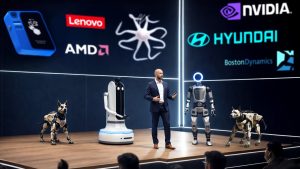Advancements in AI What’s New and What’s Next

Recent developments in the realm of artificial intelligence are stirring interest and conversation. Among these, Microsoft and OpenAI have made noteworthy moves. It is fascinating observing how these tech giants are shifting paradigms.
OpenAI’s acquisition of the chat.com domain and Microsoft’s introduction of Magentic One workflow highlight significant technological strides. These updates may not seem revolutionary, yet they pave the way for further advancements. We’ll dive into the details of what these mean for AI’s future.
OpenAI’s Strategic Domain Acquisition
OpenAI has acquired the domain “chat.com” for an estimated $15 million. This digital real estate move reflects a strategic bid to dominate online conversational AI. While seemingly minor, it underscores OpenAI’s commitment to making ChatGPT more accessible and recognizable.
This domain now serves as a direct route to ChatGPT, removing barriers for users looking to engage the AI. It’s a bold and strategic investment showcasing OpenAI’s thrust toward user-friendly AI experiences.
Microsoft’s Magentic One Workflow
Microsoft has unveiled the Magentic One workflow. This new tool allows for web browsing, file access, code writing, and execution. It’s designed to assist fully in various processes, making digital interactions smoother and more intuitive.
In an example task, Magentic One was used to order a chicken schwarma in Seattle. The tool coordinated different agents like a web Surfer and a coder, efficiently executing tasks in a seamless loop. This degree of automation marks a significant evolution in AI capabilities.
Navigating Complex Tasks
Magentic One’s ability to handle complex tasks, like ordering online, sets it apart. The orchestrator and web Surfer agents worked in tandem, retrieving information and executing actions with precision.
Its design reveals a thoughtful understanding of process management and problem-solving. Coordinating multiple agents on a single task could indeed redefine digital workflows.
Even when errors occur, these agents are adept at recovering and redirecting efforts, ensuring the task completion is both effective and timely.
Innovations in Research Applications
Microsoft’s agents can also support academic research tasks, such as citing papers. This showcases the workflow’s versatility.
Using web Surfer, it sources research papers and efficiently integrates them into documents. Its potential for automating repetitive research tasks is noteworthy.
This feature also emphasizes the tool’s potential across different fields, highlighting its power to transform traditional methods into more streamlined digital processes.
AI Workflow in Code Execution
The orchestrator in Magentic One also facilitates complex code-related tasks. It coordinates multi-stage processes across different agents. This involves accessing distinct data types and executing precise actions.
By managing these details, it fundamentally enhances the workflow’s efficiency.
Such advancements are pivotal for tech professionals and coders, easing intricate programming tasks and improving code management.
The MIT license governs Magentic One’s open-source nature, encouraging community involvement. This invites developers to enhance and adapt it.
This collaborative framework speeds up innovation, creating a dynamic ecosystem for AI growth. The open-source approach ensures continuous improvement and fosters creativity within the community.
Future of AI Agent Technology
AI agent workflows, like Magentic One, signal a shift from task-specific AI towards multi-task capabilities. This transition is reshaping technology, unlocking new possibilities.
Although not flawless, Microsoft’s initiative is a stepping stone towards more autonomous digital agents. Constant trial and error refine these systems, enhancing reliability.
The AI landscape is dynamic, with promising advancements on the horizon, particularly by 2025. This evolution promises enhance efficiency and productivity in daily operations.
Music and AI: Sunno’s V4 Model
Sunno AI has teased its V4 model, tantalizing the market with its preview. Known for AI music generation, it faces competition from Yudio and 11 Labs.
V4 surprises with clear vocals and quick synthesis of songs, indicating a leap in digital music creation.
The excitement for Sunno V4 underscores the potential of AI in transforming music production, hinting at innovations yet to come.
Technological Contributions from ByteDance
ByteDance’s latest, X Portrait 2, elevates AI lip-syncing technology. It produces authentic lip movements and facial expressions for video applications.
This breakthrough closely follows Runway’s similar tech, Act One, with X Portrait 2 boasting superior application across AI-generated imagery.
This technology holds potential in entertainment, enhancing virtual communication.
It could redefine how we create and consume media, presenting ethical and practical considerations moving forward.
These advancements highlight the vigorous pace at which AI technology is evolving. From web agents to digital music, AI’s reach is expanding.
Emphasizing collaboration and open-source developments, the future of AI promises rich innovations. Stay tuned as these technologies continue to reshape our world.







